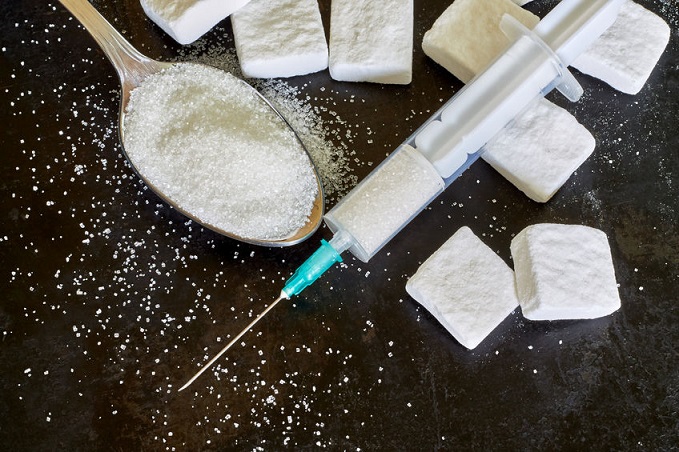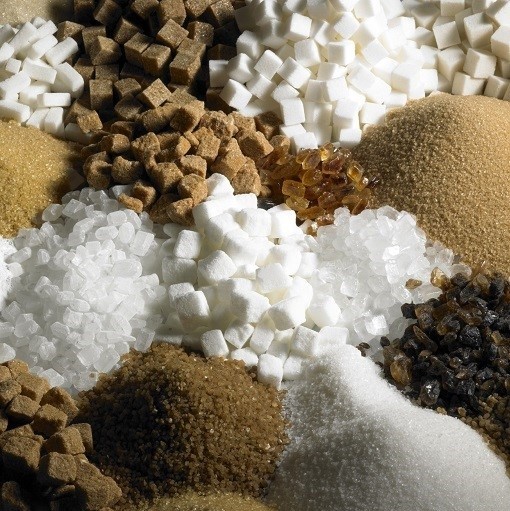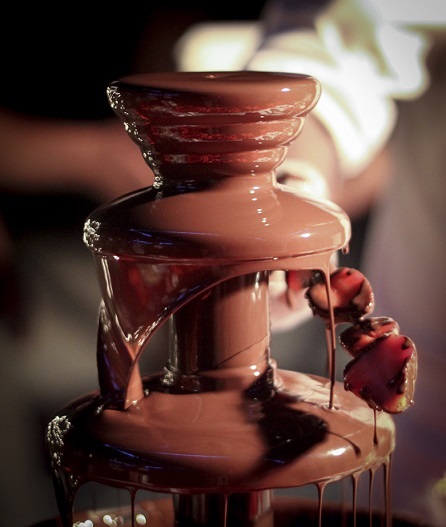 As of 2020, the real ruler of the world is not some shadowy New World Order clique, but added sugar.
As of 2020, the real ruler of the world is not some shadowy New World Order clique, but added sugar.
In 2013, the average American ate 73.1 grams of added sugar (so ignoring fruits, nuts and other natural sources), whereas before 1850, it was below 10 grams. Today, it feels completely normal to have vast rows of supermarket chocolate bars to choose from, but 100 years ago, the idea would be fantastical.
The processed food revolution was partly responsible, and people becoming convinced that saturated fat was deadly. Sugar is also so delicious that food manufacturers sprinkled it into their recipes more and more, from breaded fish to baked beans, to lure people in without having to use nicotine (which would be simpler but slightly less legal).
The other theory, however, is that sugar is addictive. That once added sugar rose to a certain level, say 40 grams, we became hooked, causing a self perpetuating spiral where Westerners craved more sugar, and food companies were only happy to oblige…
…and the final chapter is that people are still addicted to the white stuff even today. The thing is, if sugar is addictive, it’s important to know, because 1) it’s interesting, and 2) you’ll be able to prepare mentally. You don’t want to slash your intake by 100 grams a day and be caught by surprise, overwhelmed by anxiety and fatigue.
No, it’s better to understand that those symptoms are coming, and that if you stick it out like a hardened warrior, they’ll fade away as you wean off the intoxicating delights of candy and cake. Being caught by surprise is the perfect recipe for failing totally.
Therefore, here’s the full truth about sugar addiction:
2020 – the debate rages on
The first thing to know about sugar addiction is that nobody can agree on it. In the local pub, it’s settled fact that chocolate cake will hook its claws in and never let go, but in the average scientific laboratory, they scoff at the idea.
Just recently in 2017, a British study triggered a massive debate by screaming that sugar was “more addictive than cocaine”. Rats were forced to choose between either cocaine or water flavoured with intensely sweet saccharin, and 94% chose the water. They concluded that sugar had the “potential to override self-control mechanisms and thus to lead to addiction“. It sounds like a massive advancement, but big shot scientists attacked the study with a savage fury, saying that the comparison to cocaine was absolutely ridiculous.
The battle rages to this day; many insist that it’s all psychological, that there are no physical changes in the brain, and stressed people instinctively grab a tin of cookies to feel happier. It could be as simple as people not wanting to give up their favourite breakfast cereal.
At the same time, think about your own experiences: have you ever quit sugar for 10 days? Maybe you’ve done it for the sake of your skin, but become irritable, anxious or generally in a grey and low mood. Sugar dodgers ranging from Paleo diet followers to pre-diabetic patients have given in again after the cravings became unbearable.
Meanwhile, who ever reported side effects from banishing all processed vegetable oils? Or staying away from McDonald’s for a month? The real world says it all. The scientists are arguably getting so wrapped up in molecular brain science that they’re ignoring what’s right in front of them.
Here’s the official definition of addiction: “when a person compulsively uses a substance despite the negative consequences from that substance”. It fits sugar like a glove.
Sugar addiction closely mimics the behaviour of hard drugs, as people often quit for a month, but relapse into a harder binge than ever before. It often takes a single square of chocolate to unleash the cravings again, just like a single sip of beer for alcoholics (as shown in sitcoms everywhere).
Meanwhile, health bodies tend to move at a snail’s pace. Just look at the conclusion of any scientific study. No matter how overwhelming the evidence that, for example, vitamin C boosts the immune system, they’ll always finish with: “However, further studies are required to reinforce these findings“.
Arguably, it’s part of the scientific process, but it means that “official” nutritionists are incredibly slow to recommend what’s easily visible 10 years earlier using common sense. Trans-fats are a classic example. AKA partially hydrogenated fat, they were introduced in 1911 in Crisco shortening, but the first heart attack study came to light in the 1950s. The studies continued in the 1980s and became a flood in the 1990s, but it took the FDA until 2015 to finally declare them illegal.
Some people are secretly worried that if we slap an addictive label on sugar, then people will conclude that dieting is hopeless, give in, and embark on a candy and chocolate free-for-all.
So is sugar as addictive as crack cocaine, or just an entrenched habit that you need to break? It’s somewhere in between.
Sugar spikes the same players as drugs
 The fact is that eating sugar stimulates the classic brain receptors behind addiction – namely dopamine and opioid receptors.
The fact is that eating sugar stimulates the classic brain receptors behind addiction – namely dopamine and opioid receptors.
Dopamine is either called the reward hormone or the motivation hormone. Essentially, your brain releases a burst of dopamine every time you do something which the body is hardwired to consider advantageous to survival. For example: cycling up a tall mountain, or taking risks, like winning a bet at 100/1 odds.
Even succeeding at goals can release dopamine, like attempting to complete an essay in 3 hours and succeeding in 2. A torrent of dopamine is behind the pleasure or giddiness from those things, hard drugs included. It’s nature’s way of guiding human beings to success in the wild savannahs or forests, unchanged for millennia. The entire natural reward system is called the mesolimbic pathway and the dopamine pathway is found across the animal kingdom, from monkeys to fire ants.
But there’s a problem: the more you abuse dopamine-releasing substances, the more it takes to achieve the same dopamine high.
The receptors in your brain become less sensitive, or even physically shrink. Thus, drug addiction arrives. Cocaine and speed users become tolerant, requiring more and more white stuff.
The point we’re working towards here is that sugar also triggers a dopamine spike. The famous sugar rush is not just rapidly digested energy; it’s also a mental phenomenon.
Why would nature make us eat cocaine, you might ask, when it’s a nose melting, heart-pounding menace? Well originally, it comes from the leaves of the coca plant, which Native Americans in Peru chewed during ceremonies 8000 years ago. The cocaine quantities were far lower, and consequently, it provided a beneficial jolt of alertness, focus and energy, like a prehistoric cup of coffee.
But because it was so pleasurable, we took it too far, and developed industrial methods for grinding down the leaves into the massively potent crystals which rock stars love today. It’s very similar with sugar. The sweetness of fruits triggered an obsessive quest to grow the sugar cane plant, and extract the purest, tastiest form.
For instance, this 2005 study found that daily bingeing on sugar increased extracellular dopamine levels in their brain to 130% of normal, in rats fed sucrose (pure table sugar). This proves that sugar spikes dopamine, but tellingly, after 21 days, the rats steadily increased their sugar intake from 37ml to 112ml daily.
This strongly suggests that they were becoming tolerant, that the sugar paradise was steadily weakening their brain receptors. Another neurotransmitter called acetylcholine was also affected. Acetylcholine is a vital satiety hormone, the opposite of leptin, which rises to induce hunger and falls when you eat (although some obese people are permanently hungry because of leptin resistance).
Acetylcholine, meanwhile, should rise as you eat, to eventually tell your mouth “no more”, but the study found that glucose rats had a delayed acetylcholine satiety response. In conclusion, there was “neurochemical similarity between intermittent bingeing on sucrose and drugs of abuse“.
The evidence is accelerating fast. In 2018, a British review concluded that sugar produces “more symptoms than is required to be considered an addictive substance“. These included bingeing, craving, tolerance, and withdrawal.
How sugar mimics the effects of heroin
Then there’s opioid receptors, the receptors which heroin and painkillers like fentanyl stimulate, to create a floating, dreamlike high.
Here the mechanism is more indirect: sugar causes your brain to release its own, indigenous opioids, and your body becomes addicted to them. It’s not a fentanyl tab smuggled into an old coal mining town in a library book; your brain is high on its own supply, encouraged by the white stuff.
This recent 2019 study fed mini pigs sucrose for 12 days. Even a single dosage of sugar reduced the binding of carfentanil, a relative of fentanyl, by 14% in the nucleus accumbens and cingulate cortex, which was in line with decreased density of opioid receptors.
The conclusion: “the lower availability of opioid and dopamine receptors may explain the addictive potential associated with intake of sucrose“. In other words: it required more opioids to achieve the pleasurable high. The binding of the dopamine antagonist raclopride also fell, proving that dopamine receptors had shrivelled up too.
This older 2002 study really spent it out. It fed rats a 25% glucose liquid for 1-4 weeks, and then fed them naxalone, a pharmaceutical drug which blocks the effects of opioids.
Naxalone is often used to save overdose patients from breathing failure, since it works within 5 minutes. Here, it quickly induced withdrawal signs like teeth chattering, forepaw tremor, and headshakes, strongly suggesting that the rats had become addicted to their brain’s own opioids.
Importantly, naxolone does nothing to people with no opioids in their system. The alterations in brain chemistry were apparently similar to morphine or nicotine. In fact, some internet sugar addicts are recommending naxalone as a strategy. Meanwhile, a food restriction group was far less severe, only experienced teeth chattering.
The only real flaw is the lack of human studies, and to be fair, that’s for good reason: we can’t start feeding people cocaine in the name of scientific advancement.
The genesis of sugar addiction
 Even without the piles of evidence above, I would still conclude that sugar is addictive. When you eat it, you can literally feel the dopamine increase, even a burst of motivation, the same as when you complete 15 intense minutes on exercise bike.
Even without the piles of evidence above, I would still conclude that sugar is addictive. When you eat it, you can literally feel the dopamine increase, even a burst of motivation, the same as when you complete 15 intense minutes on exercise bike.
Human history tells us all we need to know. The classic theory is that we’re compelled to eat sugar because in our cavemen days, where we said “ug” a lot, crept past sleeping bears, and whacked each other over the head with wooden clubs, we were programmed to seek out high calories foods for the winter. We needed to build our fat reserves for when the plants died.
Thus, the guiding hand of dopamine steered us towards berries and pineapple. The other theory is that dopamine guided us toward sugary fruit because they were the richest source of antioxidants. This was the days before vitamin C supplements, the days before we could grind coffee beans into a convenient beverage.
Either way, the addictive potential of sugar didn’t matter back then, because our food supply was always restricted. When coming across a bountiful berry bush, we could lie around on the grass stuffing our ourselves for a whole day, getting such an intense sugar high we could jump to the moon and back (although we probably believed that it was a deity back in 20,000BC). But we would would never get addicted because the next three days would probably be spent in a hypocaloric state, hunting the forests for new food. We were always swinging back and forth between starvation and gluttony like a yoyo, so the system worked perfectly.
Nowadays, donut heaven is a simple walk to the convenience store away. Oh wait, that was 50 years ago – now we’re a simple drive away to a McDonald’s drive through. Oh wait, that was 10 years ago – we’re now a simple click away on the Walmart website!
The point is that all restrictions on our sugar consumption have now been lost. Our old evolutionary systems are spiralling out of control like a runaway mine train and rampant sugar addiction is the result.
The moodiness, the anxiety and the irritability
It’s the main reason for the gulf between the average Joe and bespectacled scientists, but sugar’s withdrawal symptoms are proven too.
Firstly, in 2015, some rats were divided into two groups: one with access to water and a sucrose solution, and one with access to only water (study). After 30 days, the sucrose was removed and their behaviour monitored for three days. The sucrose rats became significantly more impulsive, at comparable levels to hard drugs. Most critically, they were more impulsive than pre-sugar day 0, confirming “the parallel effects of addictive drugs and sugar“. The other rats became less impulsive (probably natural variation).
Secondly, we have a study all sugar dodging acne patients need to see, testing mental effects specifically. The goal: to find out whether sugar withdrawal mimicked opiate withdrawal. The methods: feeding rats 10% sucrose and rat feed for 28 days, and fasting for 36 hours.
The results: the rats spent significantly less time in the exposed section of a water maze, showing that their anxiety levels had risen.
Dopamine levels also went downhill, and the best part is that hypoglycemia wasn’t responsible. Sugar is a carbohydrate, and when you go too low carb, your body will make less of the happiness hormone serotonin, whether you’re addicted or not. Therefore, the fact that the anxiety was independent of blood sugar strengthens the evidence that sugar itself is addictive.
Our final study returned to the anxiety arena. The introduction itself was promising: “animal models indicate that repeated access to palatable foods such as sugar induces depression and anxiety-like behavior when the food is no longer available“. This time, mice were fed sucrose, which was eventually withdrawn, and this triggered depression and anxiety, or behaviour strongly suggestive of it. Reinstating the sugar reversed the behavioural changes. Analysis of their brains revealed a deficiency in dopamine, and a potassium channel in the brain called Kir2.1 was increased, which suppresses neuronal activity and leads to the fog of depression.
If you ever noticed withdrawal symptoms after attempting to the kick the sugar habit, your observations were spot on.
Sugar addiction – other internet rumours
 However, abusing sugar day after day may not be the only cause of addiction.
However, abusing sugar day after day may not be the only cause of addiction.
Imagine a pregnant woman who develops a sudden obsession with almonds or pineapple, guarding her pantry like a paranoid bear guarding its cubs. These classic cravings are supposedly in response to nutritional needs, instinctively forcing her to acquire pineapple’s vitamin C. She’s making a whole new person; that’s why the cravings are so extreme and compulsive.
Then there’s dark chocolate: some claim that “chocoholics” actually have a magnesium deficiency, as cocoa powder is extremely rich in it. Others argue that its psychoactive substances like anandamide and phenethylamine (which acts on the same brain receptors as speed) suck people in. Anemic people sometimes get a mad urge to chew ice.
Theories all over the internet state that sugar cravings have weird causes as well. Common ones include…
Candida – a yeast that exists in everyone’s gut, but can overgrow and send inflammatory molecules flowing around your bloodstream. Candida albicans is the bogeyman of the natural health world. Claims that 99% of us infected are ridiculous, but candida is still common and can wipe out friendly strains of gut bacteria.
Importantly, candida and other yeasts digest sugar for energy, with two transporter proteins called ScSnf3 and ScRgt2 which instinctively sense glucose’s presence and activate digestive enzymes. The classic candida protocol is to minimise dietary sugar.
Therefore, the theory is that candida overgrowths hijack your brain and turn you into a walking puppet, eating vast quantities of sugar with no control. This claim is everywhere on the internet, but nobody lists any evidence, they just recycle the same sentences from other websites.
The thing is though, the idea is very plausible. It makes sense that a microorganism would influence its host, and this study found that chocolate craving human beings had a different set of gut bacteria to less addicted people. Meanwhile, L. acidophilus can increase cannibinoid and opioid receptors in the gut (study), making weed and heroin all the more appealing. Mice with no gut bacteria have greater numbers of sweet receptors, and ate more sugar in the real world (study). This big review concluded that “microbes could influence food preferences by altering receptor expression“, and that acquired tastes like marmite may be due to certain species of gut bacteria thriving.
Candida has no direct studies on sugar addiction, but I wouldn’t be surprised if its puppet string powers were real.
Mineral deficiencies – another common theory. It’s simple: deficiencies in magnesium or zinc will compel you to eat sugar like a zombie. It’s the same category as candida, with no solid evidence, yet plausible.
Magnesium and zinc molecules are both used to digest sugar molecules, and they strongly affect neurotransmitters. Magnesium is a particularly happy mineral, relaxing the GABA receptors that benzos act on and even helping to manufacture serotonin.
Most importantly, 80% of Americans are deficient in it, a striking parallel to the percentage who eat too much sugar. Could obesity be solely due to the scarcity of magnesium today? The answer is no, of course not, but I wouldn’t be surprised if magnesium is important. By extension, amino acids like lysine and glycine also affect neurotransmitters and may also affect cravings.
Sleep – some people might say “duh” at this theory. It’s perfectly obvious that a tired, sleep deprived office worker might grab a couple of donuts to perk him up in the morning (particularly if he’s a police officer). However, some say that it’s deeper, that the neurological state when the brain fails to hoover up waste molecules like beta amyloid specifically heightens your sugar taste buds.
This time, we actually have studies, but they’re very mixed. This 2014 study followed 42 human beings for 4 weeks. It found that in short sleepers of less than 6 hours daily, overall sugar intake rose significantly, but so did calories. Once adjusted for calories, the difference vanished into statistical oblivion. However, free sugars (added sugar) did still increase as a proportion of overall calories. They concluded that sleeping like a baby “may be a viable strategy to facilitate limiting excessive consumption of free sugars“.
This study was a pretty feeble affair, analysing 15199 members of a 2005-2010 nutritional survey. The short sleepers (≤6 hours) ate 120 grams daily, the normal sleepers (7-8 hours) ate 116g, and the long sleepers (≥9 hours) ate 115g. It’s a difference, but a minuscule one (also, while we’re here, 115 grams is a massive amount of sugar!). The only redeeming factor was that it gathered data from a decades-long survey; it wasn’t a controlled experiment where the effect of sleep could truly be isolated.
Finally, the theory crumbles into dust in this 2013 study, which again gathered data from a long-term population survey. The long sleepers ate 101g of added sugar daily, while the very short sleepers (<5 hrs) ate 115g. For a millisecond, it looks promising, but the medium sleepers still (7-8 hrs) ate 119g, while the short sleepers (5-6 hrs) ate a massive 124g. The benefits only arrive with a lazy lie in.
The sleep deprivation theory is the weakest one, apart from to perk you up in the morning.
The verdict
The headlines that Oreos are more addictive than crack are little more than clickbait, but sugar is moderately addictive, without a doubt.
Sugar stimulates dopamine, it stimulates opioids, and tolerance builds rapidly. I highly doubt that health bodies will confess any time soon, but there’s little debate. The studies are great to have, bolstering our evidence, but they don’t change what we could already deduce with our eyes.
Your strategy? Firstly, I don’t recommend that you abstain entirely, like cocaine or heroin. Added sugar is an international acne villain, but it’s also found in acne-clearing fruits like the antioxidant-packed pomegranate, the anti-inflammatory blueberry and the wound healing pineapple. Below a certain threshold, reducing sugar becomes a net negative for acne.
The problem is that the most severely addicted people often relapse with a single taste of sweetness, and even a melon can set them off. It’s the classic pattern of relapse and bingeing seen with drugs like alcohol.
That’s why you should always be in control; you can eliminate most sugar for a while to detox, but when you reintroduce fruits and occasional sweet treats like organic yogurt, it should be as controlled as anything else. It should be the next phase of your plan, rather than a mindless act of temptation.
Once you’ve adjusted to this medium to low phase of sugar, your brain should be rebalanced, with the withdrawal symptoms waved goodbye in the rear view mirror.
Thanks for reading!
